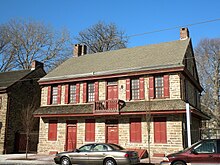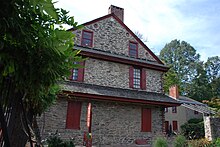
Germantown is an area in Northwest Philadelphia, Pennsylvania. Founded by Palatine, Quaker, and Mennonite families in 1683 as an independent borough, it was absorbed into Philadelphia in 1854. The area, which is about six miles northwest from the city center, now consists of two neighborhoods: 'Germantown' and 'East Germantown'.

The Germantown White House is a historic mansion in the Germantown section of Philadelphia, Pennsylvania. It is the oldest surviving presidential residence, having twice housed Founding Father George Washington during his presidency.

Hope Lodge is a historic building located at 553 South Bethlehem Pike in Fort Washington, Pennsylvania, in the United States. This mansion has been described as "one of the finest examples of Georgian Colonial architecture in this part of the country. It was used by Continental troops during the 1777 Philadelphia Campaign during the American Revolution.

The Powel House is a historic house museum located at 244 South 3rd Street, between Willings Alley and Spruce Street, in the Society Hill neighborhood of Philadelphia, Pennsylvania. Built in 1765 in the Georgian style, and embellished by second owner Samuel Powel (1738–1793), it has been called "the finest Georgian row house in the city." As with other houses of this type, the exterior facade is understated and simple, but the interior was elaborately appointed.

Carpenters' Hall is the official birthplace of the Commonwealth of Pennsylvania and a key meeting place in the early history of the United States. Carpenters' Hall is located in Independence National Historical Park in Philadelphia, Pennsylvania. Completed in 1775, the two-story brick meeting hall was built for and still privately owned by the Carpenters' Company of the City and County of Philadelphia, the country's oldest extant craft guild.

Belmont Mansion is a historic mansion located in Fairmount Park in Philadelphia. Built in the early 18th century, the mansion is one of the finest examples of Palladian architecture in the United States. Since 2007, the mansion has hosted the Underground Railroad Museum.

Stenton, also known as the James Logan Home, was the country home of James Logan, the first Mayor of Philadelphia and Chief Justice of the Pennsylvania Supreme Court during the colonial-era governance of the Province of Pennsylvania. The home is located at 4601 North 18th Street in the Logan neighborhood of North Philadelphia.
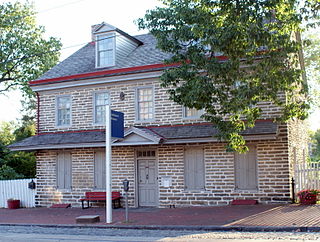
The John Johnson House is a National Historic Landmark in the Germantown section of Philadelphia, significant for its role in the antislavery movement and the Underground Railroad. It is located at 6306 Germantown Avenue and is a contributing property of the Colonial Germantown Historic District, which is also a National Historic Landmark. It is operated today as a museum open to the public.
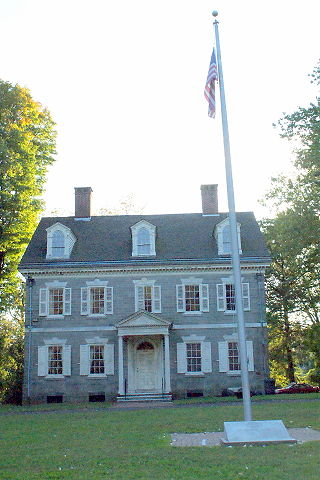
Upsala is a historic mansion in Mount Airy, Philadelphia, Pennsylvania, United States. Considered one of the finest extant examples of Federal architecture, the mansion is a contributing property of the Colonial Germantown Historic District and is listed on the National Register of Historic Places and the Philadelphia Register of Historic Places.

Historic RittenhouseTown, sometimes referred to as Rittenhouse Historic District, encompasses the remains of an early industrial community which was the site of the first paper mill in British North America. The mill was built in 1690 by William Rittenhouse and his son Nicholas on the north bank of Paper Mill Run near Philadelphia, Pennsylvania. The district, off Lincoln Drive near Wissahickon Avenue in Fairmount Park, includes six of up to forty-five original buildings. RittenhouseTown was listed on the National Register of Historic Places and was designated a National Historic Landmark District on April 27, 1992.

The Philadelphia Lazaretto was the Second quarantine hospital in the United States, built in 1799, in Tinicum Township, Delaware County, Pennsylvania. The site was originally inhabited by the Lenni Lenape, and then the first Swedish settlers. Nearby Province Island was the site of the confinement of the Christian Moravian Indians who were brought there under protective custody from Lancaster, Pennsylvania, in 1763 when their lives were threatened by the Paxton Boys. The facility predates similar national landmarks such as Ellis Island Immigrant Hospital and Angel Island and is considered both the oldest surviving quarantine hospital and the last surviving example of its type in the U.S.
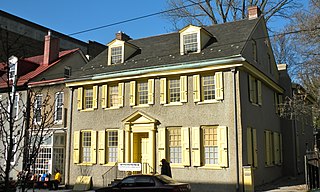
Wister is a neighborhood in Northwest Philadelphia, Pennsylvania, United States. It is bounded by Chelten Avenue to the north, Germantown Avenue to the west, Belfield Avenue to the east, and Wister Street to the south. Wister is a section within Germantown. The Clarkson-Watson House, Fisher's Lane, Grumblethorpe, Grumblethorpe Tenant House, and Ivy Lodge are listed on the National Register of Historic Places.

Lemon Hill is a Federal-style mansion in Fairmount Park, Philadelphia, built from 1799 to 1800 by Philadelphia merchant Henry Pratt. The house is named after the citrus fruits that Pratt cultivated on the property in the early 19th century.

The Ebenezer Maxwell House, operated today as the Ebenezer Maxwell Mansion, is an historic house located in the West Germantown neighborhood of Philadelphia, Pennsylvania.

The Old Germantown Academy and Headmasters' Houses or The Old Campus is an historic, American school campus, the original site of Germantown Academy, located at Schoolhouse Lane and Greene Street in Philadelphia, Pennsylvania. The academy moved to a new suburban location in 1965, and the site is currently occupied by the Pennsylvania School for the Deaf.

The Concord School House is a historic one-room schoolhouse in the Germantown section of Philadelphia, Pennsylvania. It is operated today as a museum. It is part of the Colonial Germantown Historic District which was named a National Historic Landmark District in 1965.
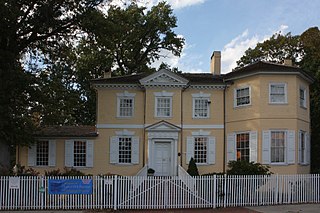
Randolph House, also known as Laurel Hill Mansion, is a historic mansion in east Fairmount Park, Philadelphia, Pennsylvania.

The Beggarstown School, built c. 1740, is a historic school in Beggarstown, Philadelphia, Pennsylvania, now part of the Mount Airy neighborhood. It is a rare example of a school building from the colonial era.

The Grumblethorpe Tenant House, also known as the Tenant House of Wister's Big House, is an historic home which is located in the Wister neighborhood of Philadelphia, Pennsylvania.

The Livezey House, also known as Glen Fern, is a historic house and mill on the east side of Wissahickon Creek in Philadelphia, Pennsylvania. It was designated on the Philadelphia Register of Historic Places on June 26, 1956.




